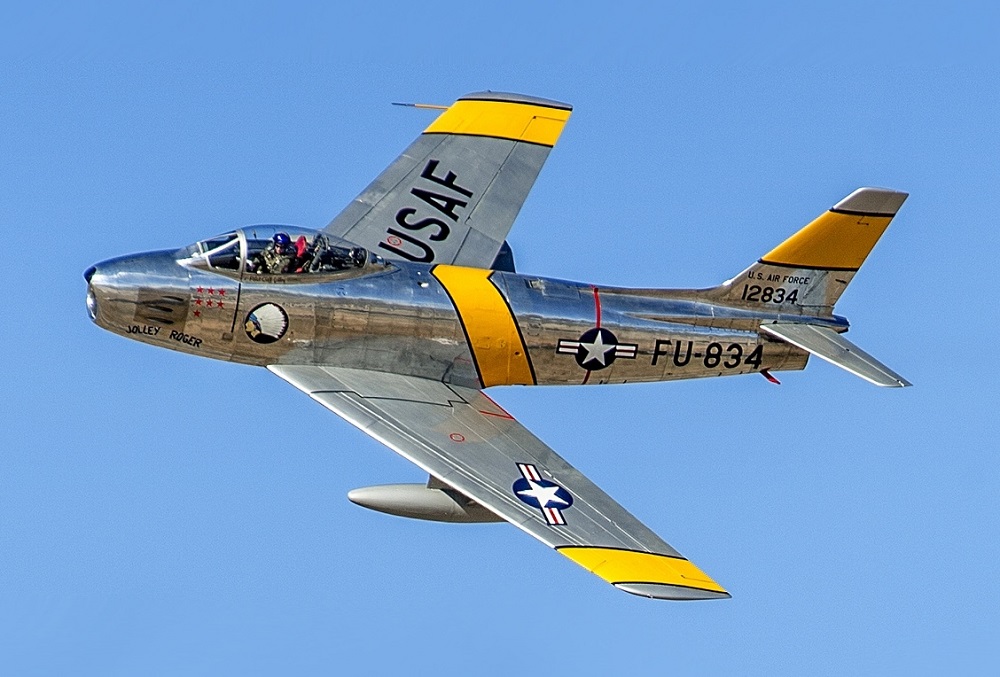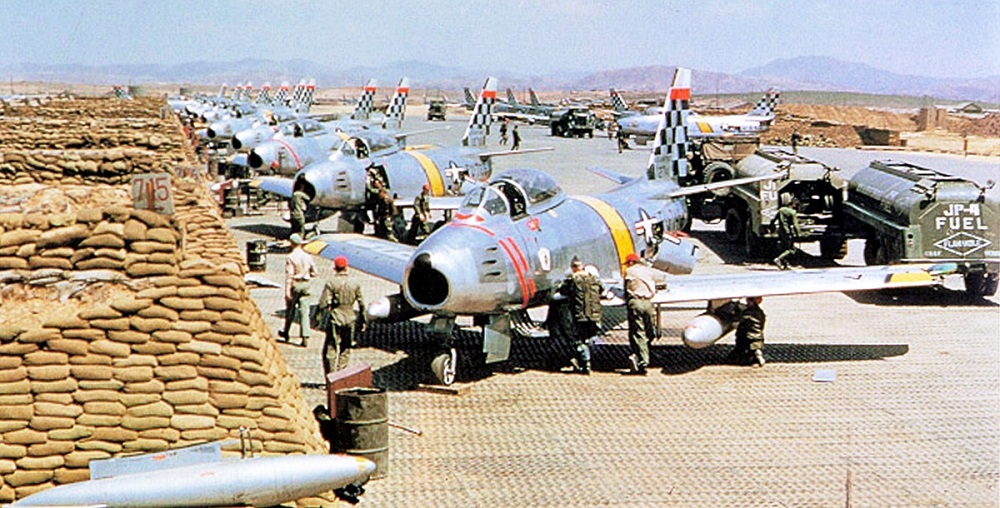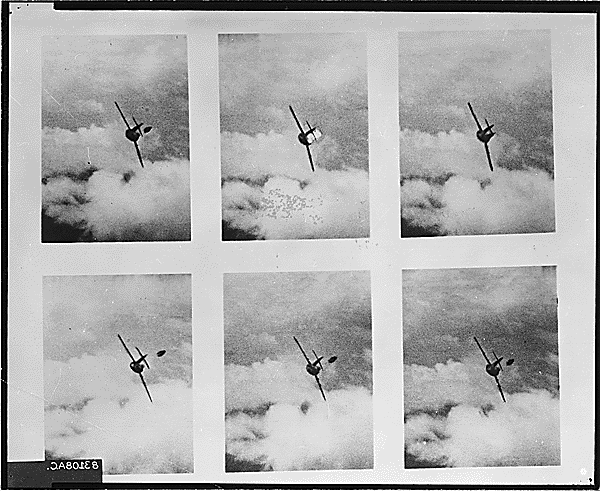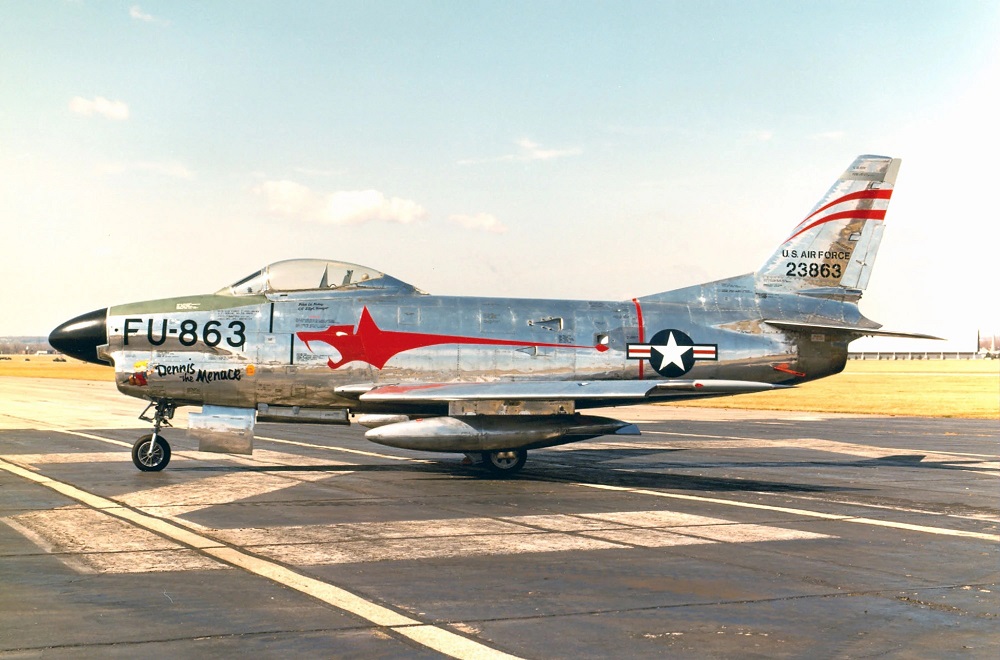
|
North American F-86 Sabre |  |
||||||||
|---|---|---|---|---|---|---|---|---|---|---|
 |
 |
 |
 |
 |
 |
 |
 |
 |
 |
 The North American F-86 Sabre was one of the greatest fighter aircraft of all time. It entered service with the USAAF in 1949 and although not as fast and maneuverable as the MiG 15, it was instrumental in denying air superiority to the Chinese during the Korean War. Afterwards, many Sabres entered service with dozens of foreign air arms, becoming the primary fighter of many Allied nations.
| |||||||||
|
The North American F-86 Sabre, often simply referred to as the "Sabre," was a legendary and iconic fighter jet that played a pivotal role in the history of aviation and military conflict during the mid-20th century. Introduced in the late 1940s, the F-86 Sabre was originally designed as a response to the emerging Soviet MiG 15 during the early stages of the Cold War. It quickly became one of the most successful and well-regarded jet fighters of its era.
It had a sleek and elegant design characterized by its swept wings, a distinctive feature that contributed to its exceptional performance. Its fuselage was long and slender, with a bubble canopy for the pilot, providing excellent visibility. The aircraft's tail section featured a distinctive "all-flying" tailplane, which enhanced maneuverability. It was powered by a General Electric J47 turbojet engine, which gave it impressive speed and agility. It had a top speed of approximately Mach 0.92 (700 mph or 1,127 km/h) and could climb rapidly to high altitudes. This combination of speed and maneuverability made it a formidable dogfighter. It was typically armed with six 0.50 caliber Browning M3 machine guns mounted in the nose, which gave it significant firepower. Later variants could carry air-to-air missiles and rockets, further enhancing its combat capabilities. The F-86 Sabre saw extensive combat during the Korean War, where it became famous for engaging in intense dogfights against Soviet-made MiG 15s. Its superior performance and the skill of its pilots contributed to the Sabre's dominance in these aerial battles, earning it a reputation as one of the best fighter aircraft of its time. Beyond its combat achievements, the F-86 Sabre played a crucial role in advancing aviation technology and tactics. It helped pave the way for the development of more advanced jet fighters and influenced subsequent generations of military aircraft. Shock Waves Early in WWII, American aircraft researchers were confronted with the problem of "shock waves" building up at the frontal surfaces of aircraft, and particularly wing and tail surfaces when the aircraft was flown at high speeds. Shock waves could and did cause complete destruction of several aircraft, notably the P-38 Lightning and P-47 Thunderbolt. Taking advantage of flight research data seized from the German Luftwaffe at the end of the war, the North American P-86 Sabre was the first American aircraft to use swept wings as was used on the German Messerschmitt Me 262. Up until this point, American jets were designed with straight rather than swept back wings.1 Although the Messerschmitt 262 had swept-wings, the sweep was only 18.5°—too negligible to affect aerodynamics. The sweep was rather due to a change in the airplane's center of gravity with engines that were heavier than expected. However, utilizing data gleaned from Luftwaffe experiments, the wings and the horizontal and vertical stabilizers of the Sabre were swept back at an angle of 35 degrees in order to delay the onset of shock waves, thus allowing higher speeds. The Beginning The origin of the Sabre began with an order on May 18, 1945, of three North American model NA-140 experimental aircraft by the US Army Air Corps.2 Originally conceived as a straight-wing aircraft the NA-140 was redesigned and designated the XP-86. To improve its design, North American technicians pored over German studies that led to development of the unconventional Me-262. They were especially interested in identifying what had given the little German jet its remarkable speed, and they eventually fastened onto a single factor: its sweptback wings. The XP-86 made its inaugural flight on October 1, 1947 at Muroc Dry Lake, California and was powered by a 4,000 pound thrust J-35-C-3 jet engine built by Chevrolet—production was later turned over to Allison. The highest speed attained was 618 mph (995 km/h) at 14,000 ft (4,267 m), it had a ceiling of around 41,300 ft (12,588 m)and its initial climb rate was 4,000 fpm (20.32 m/s). This was fantastic performance when compared to any prop-driven plane the US had produced up to the end of the war. Even North American's own prop-driven P-51 paled by comparison. Test pilots were ecstatic over the Sabre, with comments such as "...rock-steady gun platform." and "...so easy to fly you can almost control it with your thoughts". The third production F-86A-1 ("P" for "Pursuit" had been superseded by "F" for "Fighter" in 1947) equipped with a new J47-GE-13 engine of 5,200 pounds thrust (23.12 kN), set a world’s speed record of 671 mph (1,080 km/h) on September 1, 1948. The Sabre was armed with six .50-caliber M-3 machine guns in the nose, just aft of the jet intake. Target acquisition was aided by a new radar assisted gunsight. It required the pilot hold the cross hairs on his target for just one second. From then till the target was obliterated, the pilot was free of the complicated problem of adjusting for the target's range during the heat of combat.

The 51st Fighter Interceptor Wing at Suwon, South Korea. The F-86B (later redesignated F-86A-5) with a top speed of 679 mph (1,093 km/h) and initial climb rate of 7,470 fpm (37.95 m/s), represented a marked improvement over the A-1. A Wing of F-86A-5 aircraft arrived in Korea on December 13, 1950, making them the first Sabres sent to Korea. On December 17, they went into action against the awesome and hitherto invincible MiG-15. After Korea, Sabre pilots were initially credited with shooting down 792 MiGs while losing only 78 Sabres – a 10:1 kill ratio. However, these numbers were reexamined after the war. In reality, F-86 pilots likely only shot down about 200 MiGs or 25 percent of the initial estimate. The A-5 Sabre had inferior performance when compared to the MiG-15. It was slower and unable to maneuver as well as the MiG above 25,000 feet. Its service ceiling of 48,000 feet was much lower than the MiG. Nevertheless, the appearance of the Sabre was the beginning of the end for the MiG-15 in Korea. The Sabre was continuously improved throughout its 10-year production run. Each model performed better than the last. There were two major variations of the craft. The F-86C was redesignated "YF-93" and was intended to be a "penetration fighter". However, it eventually came to a dead end.

Ejection of a MiG Pilot—This unusual sequence of photos, taken by the gun camera of a USAF F-86 Sabre, shows a MiG-15 pilot abandoning his aircraft after being hit by the Sabre's gunfire. (Photo: National Archives and Records Administration) The second variation was known as the F-95 until July 1950, when it was redesignated the F-86D. It was labeled an "all weather interceptor". Some experts are of the opinion the "D" was so different from the basic model it should have retained it's F-95 designation. For one thing, the J47-GE-17 engine was equipped with an afterburner which delivered a total of 7,500 pounds thrust (33.36 kN) for take-off, giving the "D" an initial climb rate of 12,150 fpm (61.72 m/s)! The nose was shaped like a shark snout with an open mouth for an air intake. Above the mouth and projecting forward was the shark's nose, which housed a radar antenna for the Hughes E-4 automatic fire control system. More than anything, the F-86D resembled a shark right down to the fins, and should have been named so, but the Air Force brass was reluctant to pick a name with such a nautical connotation.
 The F-86D was very different from the basic model. The F-86 was the first USAF night fighter to carry only one airman and have only one engine. The fire control system was so automatic, a second airman was considered unnecessary. A pod containing twenty-four 2.75 "Mighty Mouse" air-to-air rockets was located in the belly. The pod was lowered into the airstream to fire the rockets, then quickly retracted so as not to affect the speed or handling characteristics any more than necessary. The pilot had to take great care to insure each rocket had cleared its tube when fired. If a rocket was hanging halfway out the tube and the pod retracted, the rocket would explode. If the pilot wasn't absolutely sure of the position of the rocket, he landed the Sabre with the pod extended. In one incident in 1957, at Wheelus Field, Libya, a Sabre touched down and a rocket fired and blasted a 15-foot hole in a rock security fence nearly a mile and a half away!
 The F-86 rocket pod contained twenty-four 2.75 "Mighty Mouse" air-to-air rockets. The "E" was very similar to the "A" with the same J47-GE-13 engine, but was designed to carry a bit heavier combat load. The "F" was furnished with the J47-GE-27 engine with about 700 additional pounds of thrust (3.11 kN) (no afterburner), which increased its top speed to 695 mph (1,118 km/h). Combat range was increased from 660 miles (1,062 km) to 923 miles (1,485 km). The F was the first Sabre to haul a 1,200 lb (544 kg) nuclear bomb, which was carried under the port wing. In order to safely deliver this weapon, the aircraft was also furnished with a LABS (Low Altitude Bombing System) which allowed the craft to escape the blast. The "G" designation was temporarily given to the F-86D with J47-GE-33 engines. The plane was produced as the F-86D. The F-86H was specifically designed as a fighter-bomber. It had the much more powerful J73-GE-30 Engine of 8,920 lbs thrust (39.67 kN) with afterburner. Its combat range was extended to 1,038 miles (1,670 km). Later editions of the "H" had the wing slats removed and the leading edges extended. The wing tips were also extended to provide better maneuverability at high altitude. The H-5 and H-10 had the six .50 caliber machine guns removed and replaced with four 20 mm M-39's for greater hitting power.3 The last version was the F-86K intended for NATO use and was assembled in Italy by Fiat. It equipped, Italy, Norway, France, the Netherlands and West Germany. Some later went to Turkey and Thailand.4 About 6,200 Sabres were built in the US before production ceased in December 1956. Altogether there were 9,860 F-86 Sabres built in the US and 25 other countries around the world. |
| Specifications: | ||
|---|---|---|
| North American F-86F-30 | ||
| Dimensions: | ||
| Wing span: | 39 ft 1 in (11.91 m) | |
| Length: | 37 ft 0 in (11.27 m) | |
| Height: | 14 ft 0 in (4.26 m) | |
| Wing Area: | 288 sq ft (26.75 sq m) | |
| Weights: | ||
| Empty: | 10,815 lb (4,906 kg) | |
| Gross T/O: | 17,772 lb (8,061 kg) | |
| Performance: | ||
| Maximum Speed: | 688 mph (1,107 km/h) @ sea level. | |
| Service Ceiling: | 48,000 ft (14,630 m) | |
| Cruising Speed: | 513 mph (826 km/h) | |
| Normal Range: | 463 miles (745 km) | |
| Maximum Range: | 1,317 miles (2,120 km) | |
| Powerplant: | ||
| Single J47-GE-27 (no afterburner) rated @ 5,910 lbs (2,708 kg) thrust | ||
| Armament: | ||
|
Six .50 caliber M-3 machine guns - 265 rpg. 2,000 lb (907 kg) bombs or 16 x .5 in rockets. | ||
Endnotes:
|
1. Robert Jackson. F-86 Sabre, The Operational Record. Shrewsbury, England: Airlife Publishing, 1994. 3. 2. Ibid. 3. Michael Taylor and John Taylor, ed. Encyclopedia of Aircraft. New York: G. P. Putnam's and Sons, 1978. 176. 4. Ibid. 177.
©Larry Dwyer. The Aviation History Online Museum.
All rights reserved. |